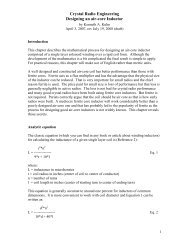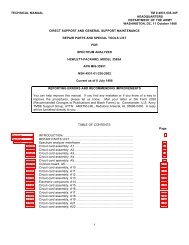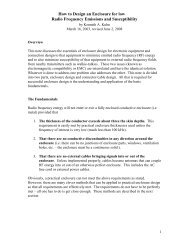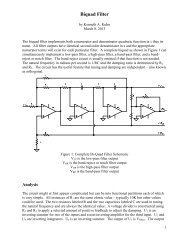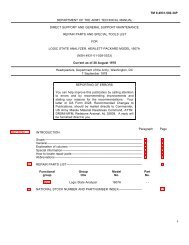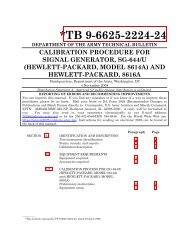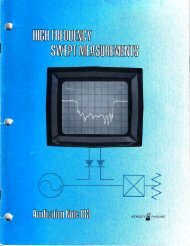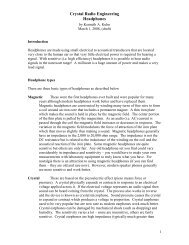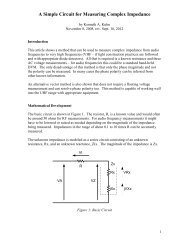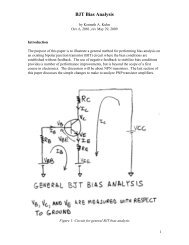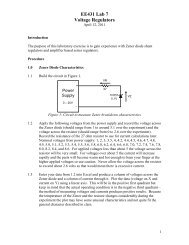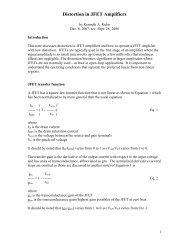Crystal Radio Engineering Introduction - Ken Kuhn's
Crystal Radio Engineering Introduction - Ken Kuhn's
Crystal Radio Engineering Introduction - Ken Kuhn's
Create successful ePaper yourself
Turn your PDF publications into a flip-book with our unique Google optimized e-Paper software.
<strong>Crystal</strong> <strong>Radio</strong> <strong>Engineering</strong><br />
<strong>Introduction</strong><br />
by <strong>Ken</strong>neth A. Kuhn<br />
Jan. 6, 2008 (draft)<br />
<strong>Introduction</strong><br />
The purpose of this book is to illustrate applied engineering concepts and the associated<br />
thought process to electrical engineering students by using a project that is historical as<br />
well as fun. The goal is to learn engineering methods and then apply those to design and<br />
build a working crystal radio.<br />
A crystal radio receives amplitude modulated signals generally in the AM broadcast band<br />
and produces an audio signal to earphones or even a speaker using only the energy of the<br />
received signal–no external power source is required. These radios have sometimes<br />
been called free power radios. <strong>Crystal</strong> sets (another name they go by) were used in the<br />
early days of radio prior to the development of vacuum tube amplifiers. A crystal radio<br />
consists of the following components:<br />
A wire antenna, typically 8 to 40 meters in length at a typical height of 3 to 8<br />
meters, and corresponding earth ground to receive radio frequency energy<br />
An antenna tuning or matching system to couple power from the antenna to the<br />
first resonant circuit that is tuned to the desired station<br />
A resonant circuit (sometimes more than one) to select the frequency of the<br />
desired broadcast station<br />
A crystal detector to demodulate the AM signal thus producing an audio signal<br />
from the modulation<br />
An earphone or speaker to convert the audio signal to sound<br />
The author has built a number of crystal radios over the years and it was a childhood<br />
quest to learn how to build the best crystal radio possible. In fact, an interest in crystal<br />
radios and radios in general led the author to become an electrical engineer. One of the<br />
radios built by the author could power a speaker such that the station could be readily<br />
heard on the opposite side of a quiet room–and it could be tuned to different stations<br />
with minimal interference. Although it was based on some good concepts, that event was<br />
blind luck in the author’s youthbut it did establish a benchmark for later life. Over the<br />
years the author has spent many hours of engineering trying to determine and explain the<br />
conditions required to replicate that radio. This book is the result. If an experiment can<br />
be replicated then it is science–and the author strongly believes in science. Otherwise it<br />
is magic and of no use. This book explains how you can use science and engineering to<br />
replicate that radio.<br />
A major error made by students and even practicing engineers is to skimp the proper<br />
research and design process and jump to building hardware as soon as possible–this<br />
process is known as hacking–with luck it works–but it is mostly a waste of time.<br />
Before you can do design engineering you must have data and mathematical models of<br />
what you are trying to do. Sometimes data is readily available. Other times such as<br />
1
<strong>Crystal</strong> <strong>Radio</strong> <strong>Engineering</strong><br />
<strong>Introduction</strong><br />
when you are doing something that has never been done before, only minimal if any data<br />
exists. Mathematical models may have errors or be incomplete based on knowledge you<br />
do not yet know. Thus, it is not uncommon for an experimental system to be constructed<br />
on a small scale in order to obtain data and refine and prove the mathematical models<br />
prior to expending a lot of time and money on the real system. The key to successful<br />
engineering is proper research done prior to the design phase. A crystal radio is an<br />
excellent example to demonstrate this because if any step is not understood or engineered<br />
well then the radio will not work well. The following chapters will illustrate the process<br />
from beginning to end.<br />
Figure 1 shows a simple crystal radio that will be discussed in great detail in this book.<br />
The circuit illustrates each of the bullet points above.<br />
Figure 1: Simple <strong>Crystal</strong> <strong>Radio</strong><br />
2



